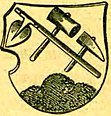Mikołajowice
| Mikołajowice | ||
|---|---|---|

|
|
|
| Basic data | ||
| State : | Poland | |
| Voivodeship : | Lower Silesia | |
| Powiat : | Legnicki | |
| Gmina : | Legnickie Pole | |
| Geographic location : | 51 ° 8 ' N , 16 ° 17' E | |
| Residents : | 410 | |
| Telephone code : | (+48) 76 | |
| License plate : | DLE | |
| Economy and Transport | ||
| Street : | A4 Wroclaw - Legnica | |
| Next international airport : | Wroclaw | |
Mikołajowice (German: Nikolstadt ) is a village in the Legnickie Pole municipality in Poland . It is located 12 km southeast of Liegnitz and belongs to the powiat Legnicki in the Lower Silesian Voivodeship .
history
In the village of Niklasdorf , four kilometers southeast of Wahlstatt , gold deposits were discovered in 1340 and mining began. In 1345, Duke Wenzel I of Liegnitz, together with his brother Ludwig I , elevated the place to town and Niklasdorf received the same mountain privileges as Goldberg . However, the city rights of Niklasdorf were restricted by the fact that the older cities of the Duchy of Liegnitz were confirmed their market and mileage rights on April 13, 1345 .
Within a short time the city of Liegnitz gained more and more influence in Niklasdorf. In 1346 the dukes ceded the yield and in 1352 the market and lap rights to the wealthy city of Liegnitz, which in return granted financial support. As early as 1364, the short time of the mountain town of Niklasdorf was over and the gold mines were shut down.
Around 1500 the previous place name was changed to Nikolstadt.
Between 1404 and 1868 there were several unsuccessful attempts to resume gold mining .
The city of Liegnitz, which had owned the Vogtei since 1464 and the manor since 1586 , lost interest in Nikolstadt and exchanged the estate for the Greibnig Chamber Estate in 1622 .
Instead of gold mining, the place lived from the stone crushing in the 17th and 18th centuries .
In the 17th century Nikolstadt lost its town charter and became a church village. The residents no longer had any occupations in the city, only the community leader referred to himself as mayor until 1945 .
The quartzite quarries have been in operation again since the end of the Second World War .
In 2000, a quartzite block with a memorial plaque was erected in the village on the occasion of the 655th anniversary of the elevation to the status of a mountain town.
Population development
| year | 1789 | 1825 | 1905 | 1939 |
| population | 422 | 488 | 534 | 440 |
